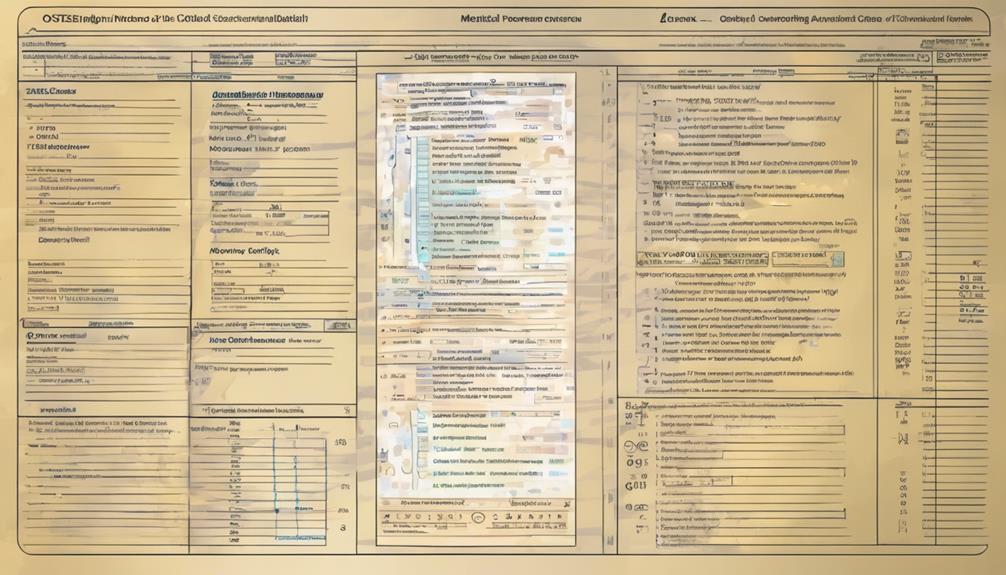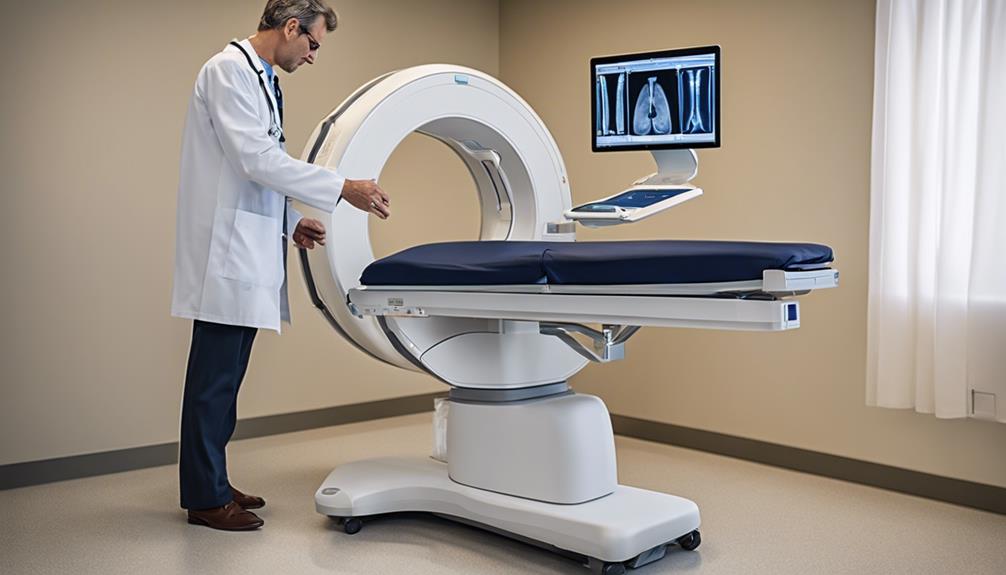In the vast world of medical coding, the ICD-10 system serves as a valuable tool, guiding us through the complex landscape of healthcare documentation.
However, within this expansive coding universe lies a specific constellation – the Osteoporosis Screening ICD-10 code.
As we explore the significance of this code in patient care and billing practices, we uncover a crucial link that shapes the foundation of preventive healthcare.
Understanding how this code operates is not merely about categorization but rather about enhancing the quality of care and patient outcomes.
Key Takeaways
- Z13.820 crucial for early osteoporosis detection.
- Accurate Z13.820 coding supports billing.
- Detailed documentation aids in proper reimbursement.
- Early intervention with Z13.820 improves patient outcomes.
Importance of Osteoporosis Screening
Osteoporosis screening plays a pivotal role in the early detection of bone density issues, crucial for timely interventions and preventing complications. Utilizing the ICD-10 code Z13.820 for encounters related to osteoporosis screening ensures accurate documentation and billing processes.
By identifying individuals at risk for osteoporosis fractures through screening, healthcare providers can initiate appropriate interventions promptly. Proper coding not only aids in effective communication between healthcare professionals but also facilitates the provision of necessary care to patients.
Timely screenings can lead to the implementation of preventive measures, such as lifestyle modifications or pharmacological interventions, reducing the risk of osteoporosis-related complications. Ensuring that osteoporosis screenings are conducted regularly and documented with the correct ICD-10 codes is fundamental in promoting bone health and overall well-being.
It's through these meticulous processes that we can safeguard the health of individuals and contribute to their quality of life.
ICD-10 Codes Overview

Let's explore the essential aspects of ICD-10 codes related to osteoporosis screening. Understanding coding guidelines is crucial for accurate documentation and billing.
We'll highlight common ICD-10 codes used in osteoporosis screening and emphasize the significance of precise coding practices.
Coding Guidelines for ICD-10
In our coding guidelines for ICD-10, the Z13.820 code plays a crucial role in accurately documenting and billing for osteoporosis screening services.
When utilizing this code, it's important to note:
- Z13.820 is specifically for screening purposes and not for diagnosing osteoporosis.
- Proper usage of Z13.820 ensures reimbursement for osteoporosis screening services.
- The Z13.820 code indicates patients undergoing screening for osteoporosis, not a confirmed diagnosis.
- This code is essential for accurate billing and documentation when patients are screened for osteoporosis.
Utilizing Z13.820 appropriately guarantees precise recording of osteoporosis screening encounters and facilitates correct reimbursement processes.
Common Osteoporosis ICD-10 Codes
Utilizing appropriate ICD-10 codes is crucial in accurately documenting and billing for various aspects of healthcare services, including osteoporosis screening procedures. When it comes to osteoporosis screening, the common ICD-10 code used is Z13.820. This code specifically denotes an encounter for screening for osteoporosis, emphasizing the preventive nature of the visit rather than a confirmed diagnosis.
By applying Z13.820 correctly, healthcare providers ensure that the purpose of the encounter is clearly communicated for billing and documentation purposes. It's important to remember that this code is reserved for screening purposes only and shouldn't be used for diagnosing osteoporosis.
Proper utilization of Z13.820 plays a significant role in facilitating accurate reimbursement for osteoporosis screening services.
Importance of Accurate Coding
Accurate ICD-10 coding plays a critical role in ensuring precise identification during healthcare encounters, aiding in effective billing for essential screening procedures like bone density tests. When it comes to osteoporosis screening, using the correct code, such as Z13.820, is vital for tracking and monitoring the screening processes.
Here are some key points highlighting the importance of accurate coding:
- Z13.820 is specifically designated for encounters related to osteoporosis screening.
- Proper coding with Z13.820 supports healthcare providers in identifying individuals who may benefit from osteoporosis preventive measures.
- Accurate coding facilitates appropriate billing for screening procedures crucial for osteoporosis risk assessment.
- Utilizing the correct ICD-10 code enhances the efficiency of healthcare services related to osteoporosis screening.
Coding Guidelines for Osteoporosis Screening

When coding for osteoporosis screenings, it's crucial to adhere to the ICD-10 guidelines for accurate reporting. Understanding the specific ICD-10 code, Z13.820, designated for osteoporosis screening encounters is essential. Proper coding not only ensures compliance but also facilitates appropriate billing for these screening services.
Coding for Screenings
In coding for osteoporosis screenings, it's crucial to correctly apply the ICD-10 code Z13.820. When using this code, remember:
- Use Z13.820 for encounters related to screening for osteoporosis.
- Z13.820 doesn't represent a diagnosis but signifies the patient is undergoing osteoporosis screening.
- Accurate application of Z13.820 ensures proper billing and documentation.
- This code enables reimbursement for osteoporosis screening services.
Proper utilization of Z13.820 is fundamental for coding and billing accuracy during osteoporosis screening encounters. By adhering to these guidelines, healthcare providers can effectively document and bill for osteoporosis screenings, ensuring quality care for patients.
ICD-10 Guidelines
Let's smoothly shift our focus to the current subtopic on ICD-10 Guidelines by emphasizing the importance of correctly applying the code Z13.820 for osteoporosis screening encounters. When using ICD-10 codes for osteoporosis screening, it is crucial to remember that Z13.820 is specifically designed for this purpose. Here is a breakdown of the key ICD-10 guidelines for osteoporosis screening:
| Code | Description | Notes |
|---|---|---|
| Z13.820 | Encounter for screening for osteoporosis | Indicates screening, not a diagnosis |
| Z13.820 | Not acceptable as principal diagnosis | Specifically for screening purposes |
| Z13.820 | Ensures billing accuracy for osteoporosis screening | Essential for accurate documentation |
Proper utilization of Z13.820 guarantees accurate documentation and billing practices for osteoporosis screening encounters.
Billing Considerations
For accurate billing in osteoporosis screening encounters, it's crucial to adhere to the specific coding guidelines associated with the ICD-10 code Z13.820.
- Ensure Z13.820 is used exclusively for osteoporosis screening encounters.
- Document the encounter with Z13.820 to indicate the purpose of screening for osteoporosis.
- Proper utilization of Z13.820 guarantees precise reimbursement for osteoporosis screening services.
- Healthcare providers rely on Z13.820 when diagnosing and billing for osteoporosis screening procedures.
Commonly Used ICD-10 Codes

When selecting ICD-10 codes for osteoporosis screening, healthcare providers commonly utilize the code Z13.820 to indicate the encounter for this specific preventive service. It's important to note that Z13.820 isn't a diagnosis but rather signifies screening for osteoporosis. This code is crucial for accurate billing and documentation when patients undergo osteoporosis screening.
Patients undergoing screening may also receive bone density tests such as DXA, QCT, BCT, and REMS to assess their bone health. By using Z13.820 appropriately, healthcare providers ensure proper reimbursement for the services provided during osteoporosis screening.
Understanding the distinction between diagnostic codes and encounter codes like Z13.820 is essential for ensuring that the screening process is accurately documented and billed. Healthcare professionals play a vital role in utilizing the correct ICD-10 codes to support effective osteoporosis screening procedures and facilitate optimal patient care.
Documentation Tips for Healthcare Providers

Moving from the discussion on commonly used ICD-10 codes for osteoporosis screening to the current focus on Documentation Tips for Healthcare Providers, accurate and detailed documentation plays a crucial role in ensuring optimal patient care and effective billing practices. Clinical documentation should include the Z13.820 ICD-10 code when documenting osteoporosis screening to support proper billing and coding.
It's essential to document the reason for screening, such as age, risk factors, or family history of osteoporosis. Specify the type of screening test performed, whether it's DXA, QCT, BCT, or REMS, to provide a clear picture of the patient's assessment. Ensure accurate documentation of screening results and any follow-up recommendations to facilitate continuity of care.
Billing Considerations for Osteoporosis Screening

Detailed documentation of the ICD-10 code Z13.820 is crucial for accurate reimbursement and efficient billing processes related to osteoporosis screening services. When billing for osteoporosis screening, healthcare providers must ensure that the encounter information is accurately linked to the Z13.820 code. This code is specifically designed for documenting encounters focused on osteoporosis screening, enabling proper reimbursement for these services. By utilizing Z13.820 correctly, healthcare providers can streamline the billing process and reduce the risk of claim denials or delays.
Healthcare professionals should pay close attention to the documentation guidelines associated with Z13.820 to ensure compliance with billing requirements. Including specific details such as the type of screening performed, patient risk factors, and the reason for the screening can help support the medical necessity of the service. Proper documentation not only facilitates accurate reimbursement but also contributes to comprehensive patient care by ensuring that all relevant information is captured for billing purposes. Remember, accurate documentation and coding are essential for successful billing outcomes when providing osteoporosis screening services.
Reimbursement Processes for ICD-10 Codes

Proper utilization of the Z13.820 ICD-10 code is pivotal in ensuring accurate reimbursement and billing for osteoporosis screening services. When it comes to reimbursement processes for ICD-10 codes like Z13.820, it's crucial to understand the following:
- Specific Identification: The Z13.820 code is specifically designed to indicate that a patient is undergoing screening for osteoporosis, aiding in precise documentation.
- Billing Accuracy: Healthcare providers should consistently use the Z13.820 ICD-10 code when conducting osteoporosis screening to facilitate proper reimbursement.
- Documentation Importance: Billing processes for osteoporosis screening heavily rely on the correct application of the Z13.820 ICD-10 code in medical documentation.
- Facilitated Reimbursement: Reimbursement for osteoporosis screening procedures is streamlined and accurate through the utilization of the Z13.820 ICD-10 code in billing procedures.
Advantages of Accurate Coding

What advantages do accurate coding provide for osteoporosis screening services? Accurate coding in bone density screenings offers numerous benefits, including ensuring appropriate reimbursement, tracking screening trends, identifying high-risk populations, facilitating data analysis, and promoting regulatory compliance. Let's delve into the advantages of accurate coding through the table below:
| Advantages of Accurate Coding for Osteoporosis Screening Services |
|---|
| 1. Appropriate Reimbursement: Ensures proper payment for bone density screenings. |
| 2. Tracking Trends: Helps monitor screening patterns effectively. |
| 3. Identifying High-Risk Populations: Enables pinpointing individuals who require targeted interventions. |
| 4. Data Analysis: Facilitates the use of data for quality improvement initiatives. |
| 5. Regulatory Compliance: Supports adherence to screening procedure regulations. |
Accurate coding not only streamlines the administrative aspects of bone density screenings but also plays a crucial role in enhancing patient care and outcomes.
Impact on Patient Care and Outcomes

Our team has observed a significant impact on patient care and outcomes resulting from early osteoporosis screening using the ICD-10 code Z13.820. This proactive approach has led to several key benefits:
- Timely Diagnosis and Intervention: Screening with Z13.820 allows for the identification of osteoporosis in its early stages, enabling prompt treatment and management.
- Prevention of Fractures: Early detection through osteoporosis screening helps in implementing preventive measures, reducing the risk of fractures in at-risk individuals.
- Cost Reduction: By intervening early with Z13.820 screening, healthcare costs related to osteoporosis complications and treatments can be minimized.
- Enhanced Quality of Life: Identifying individuals at risk through Z13.820 screening facilitates proactive bone health management, leading to improved patient outcomes and overall quality of life.
The effective utilization of ICD-10 codes, such as Z13.820, in osteoporosis screening plays a crucial role in enhancing patient care and ensuring better health outcomes for individuals susceptible to this condition.
Frequently Asked Questions
What Is the ICD-10 Code for Screening for Osteoporosis?
We use the ICD-10 code Z13.820 for osteoporosis screening. This code is specifically designed for encounters related to screening for osteoporosis and signifies that a patient is undergoing screening for this condition.
Using Z13.820 is crucial for accurately documenting and billing for osteoporosis screening, ensuring proper reimbursement. This code should be applied when patients are screened for osteoporosis outside of any current illness or injury scenarios.
What Is Diagnosis Code Z13 89?
We understand the importance of accurate coding in healthcare.
Diagnosis code Z13.89, in ICD-10, refers to an Encounter for screening for various disorders. It's vital for tracking preventive health screenings like those for diabetes, hypertension, and osteoporosis. Proper use of this code ensures precise billing and documentation for screening services.
It doesn't represent a definitive diagnosis but signifies a screening encounter for healthcare purposes. Trust that Z13.89 plays a crucial role in healthcare documentation.
What Is the CPT Code for Osteoporosis Screening?
We use CPT code 77080 for osteoporosis screening with a central dual-energy X-ray absorptiometry (DEXA) scan. This code is specific to bone density testing, covering the technical component of the DEXA scan procedure.
Healthcare providers rely on this code to bill accurately for bone density assessments during osteoporosis screening. Using CPT code 77080 ensures proper billing and reimbursement for the services provided in osteoporosis screening.
What Diagnosis Code Should Be Used for a Bone Density Test?
When determining the diagnosis code for a bone density test, it's crucial to use Z13.820. This code is specifically designed for encounters related to screening for osteoporosis.
By employing Z13.820 accurately, healthcare providers can identify individuals at risk for osteoporosis through screening encounters.
Using the correct code, like Z13.820, ensures precise billing and documentation for bone density tests, aiding in comprehensive patient care and management.
Conclusion
In conclusion, like a compass guiding us through a dense forest, accurate ICD-10 coding for osteoporosis screening is essential for ensuring patients receive the necessary care and treatment for their bone health.
By following coding guidelines and documenting screenings correctly, healthcare providers can pave the way for early detection and management of osteoporosis.
Let's continue to use these codes as our map to better patient outcomes and improved quality of care.









